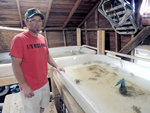 Riviera Beach
Riviera BeachA Few Clouds, 59°
Wind: 3.5 mph, S
 Riviera Beach
Riviera Beach


They’re known as “beautiful swimmers,” but to watermen on the Chesapeake Bay, blue crabs have been elusive swimmers so far this summer.
“The whole west shore has been pretty slow,” said Bill Scerbo, president of the Anne Arundel Watermen’s Association. “I don’t know what to attribute that to: freshwater or catfish. It’s been an anomalous year. I haven’t seen a season this slow in a long time.”
Pasadena waterman C.J. Canby has faced the same dilemma.
“The start has been bad,” Canby said. “The winter was fairly mild, so what saved us was that the crabs lived during the winter.”
The slow start is perplexing. The Department of Natural Resources released its blue crab winter dredge survey in May, showing that the blue crab population increased by 223 million for a total of 594 million.
After Maryland received nearly 72 inches of rain in 2018, keeping crabs from migrating to their spawning grounds, watermen were hopeful for a better year in 2019.
Stoney Creek Inn owners Dan and Jenna Van Sass are turning to other states to stock their supply.
“We are getting Texas and Louisiana crabs because we don’t have enough Maryland crabs to sustain the demand,” Jenna said. “People love the flavor of a Maryland crab. The meat is going to be more dense and sweet, normally, because of the brackish water.”
The Chesapeake Bay is an estuary with a mix of fresh and salt water. Too much fresh water gives rise to invasive species like snakehead fish and also blue catfish, which prey on blue crabs.
Bill Sielig, executive director of the Chesapeake Bay Seafood Industries Association, is not worried about the slow start.
Sielig said, “I don’t think it’s as dire as many people are saying. There’s so much freshwater, I think there’s going to be plenty of crabs. Restaurants will always find crabs, if not in Maryland then in Virginia or somewhere else.”
Canby expects the crabs to come north eventually, making for a solid season. Until then, he will continue his routine. Five days a week, he wakes at 4:15am to prepare his supplies and grab bait and fuel. He meets three crew members around 6:00am, and it takes them five and half hours to fish 500 traps.
Because he used to monitor water quality for the Department of Natural Resources, Canby is familiar with the reasons crabs may not to be plentiful: cold weather, lack of oxygen, predators.
Restaurant patrons see crab prices rising, he said, but they might not understand all of the costs associated with bringing their crabs to the table.
The price of bait and clams went up, replacement traps are expensive, and flooding in Louisiana has affected the supply, he said. Sielig said it’s the nature of an unpredictable business.
“Watermen always have problems because it’s hard to predict,” Sielig said. “They never know day to day what they’re going to get. They’re seeing these fluctuations day to day on an acute level.”
Even though recreational crabbing season started April 1, Jenna said now is the time when restaurants see plentiful blue crabs.
“The water is still 60 degrees on Memorial Day,” she said. “If you’re not ready to go swimming, the crabs probably aren’t ready to be picked. If people want Maryland crabs, the best time is July through October, sometimes even November.
“Just because a crab is big doesn’t mean it is full of meat,” she added. “We sort by weight and size. You could pay for big crabs but be wasting your money if it’s not full of meat.”
There is one truth for which everyone agrees. “They’ll find their way north eventually,” Scerbo said. “The price has gone up and demand is strong as ever.”
Comments
No comments on this item Please log in to comment by clicking here